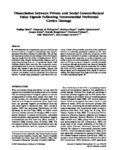Dissociation between Private and Social Counterfactual Value Signals Following Ventromedial Prefrontal Cortex Damage
| dc.contributor.author | Bault, Nadège | |
| dc.contributor.author | di Pellegrino, G | |
| dc.contributor.author | Puppi, M | |
| dc.contributor.author | Opolczynski, G | |
| dc.contributor.author | Monti, A | |
| dc.contributor.author | Braghittoni, D | |
| dc.contributor.author | Thibaut, F | |
| dc.contributor.author | Rustichini, A | |
| dc.contributor.author | Coricelli, G | |
| dc.date.accessioned | 2020-05-01T11:31:49Z | |
| dc.date.available | 2020-05-01T11:31:49Z | |
| dc.date.issued | 2019-05 | |
| dc.identifier.issn | 0898-929X | |
| dc.identifier.issn | 1530-8898 | |
| dc.identifier.uri | http://hdl.handle.net/10026.1/15622 | |
| dc.description | No embargo required. | |
| dc.description.abstract |
<jats:p> Individuals learn by comparing the outcome of chosen and unchosen actions. A negative counterfactual value signal is generated when this comparison is unfavorable. This can happen in private as well as in social settings—where the foregone outcome results from the choice of another person. We hypothesized that, despite sharing similar features such as supporting learning, these two counterfactual signals might implicate distinct brain networks. We conducted a neuropsychological study on the role of private and social counterfactual value signals in risky decision-making. Patients with lesions in the ventromedial prefrontal cortex (vmPFC), lesion controls, and healthy controls repeatedly chose between lotteries. In private trials, participants could observe the outcomes of their choices and the outcomes of the unselected lotteries. In social trials, participants could also see the other player's choices and outcome. At the time of outcome, vmPFC patients were insensitive to private counterfactual value signals, whereas their responses to social comparison were similar to those of control participants. At the time of choice, intact vmPFC was necessary to integrate counterfactual signals in decisions, although amelioration was observed during the course of the task, possibly driven by social trials. We conclude that if the vmPFC is critical in processing private counterfactual signals and in integrating those signals in decision-making, then distinct brain areas might support the processing of social counterfactual signals. </jats:p> | |
| dc.format.extent | 639-656 | |
| dc.format.medium | Print-Electronic | |
| dc.language | en | |
| dc.language.iso | en | |
| dc.publisher | MIT Press - Journals | |
| dc.subject | Decision Making | |
| dc.subject | Female | |
| dc.subject | Formative Feedback | |
| dc.subject | Humans | |
| dc.subject | Learning | |
| dc.subject | Male | |
| dc.subject | Middle Aged | |
| dc.subject | Prefrontal Cortex | |
| dc.subject | Risk | |
| dc.subject | Social Behavior | |
| dc.title | Dissociation between Private and Social Counterfactual Value Signals Following Ventromedial Prefrontal Cortex Damage | |
| dc.type | journal-article | |
| dc.type | Journal Article | |
| dc.type | Research Support, Non-U.S. Gov't | |
| plymouth.author-url | https://www.webofscience.com/api/gateway?GWVersion=2&SrcApp=PARTNER_APP&SrcAuth=LinksAMR&KeyUT=WOS:000476846600002&DestLinkType=FullRecord&DestApp=ALL_WOS&UsrCustomerID=11bb513d99f797142bcfeffcc58ea008 | |
| plymouth.issue | 5 | |
| plymouth.volume | 31 | |
| plymouth.publication-status | Published | |
| plymouth.journal | Journal of Cognitive Neuroscience | |
| dc.identifier.doi | 10.1162/jocn_a_01372 | |
| plymouth.organisational-group | /Plymouth | |
| plymouth.organisational-group | /Plymouth/Faculty of Health | |
| plymouth.organisational-group | /Plymouth/Faculty of Health/School of Psychology | |
| plymouth.organisational-group | /Plymouth/REF 2021 Researchers by UoA | |
| plymouth.organisational-group | /Plymouth/REF 2021 Researchers by UoA/UoA04 Psychology, Psychiatry and Neuroscience | |
| plymouth.organisational-group | /Plymouth/Users by role | |
| plymouth.organisational-group | /Plymouth/Users by role/Academics | |
| dc.publisher.place | United States | |
| dcterms.dateAccepted | 2019-01-11 | |
| dc.rights.embargodate | 2019-6-29 | |
| dc.identifier.eissn | 1530-8898 | |
| dc.rights.embargoperiod | Not known | |
| rioxxterms.versionofrecord | 10.1162/jocn_a_01372 | |
| rioxxterms.licenseref.uri | http://www.rioxx.net/licenses/all-rights-reserved | |
| rioxxterms.licenseref.startdate | 2019-05 | |
| rioxxterms.type | Journal Article/Review |


